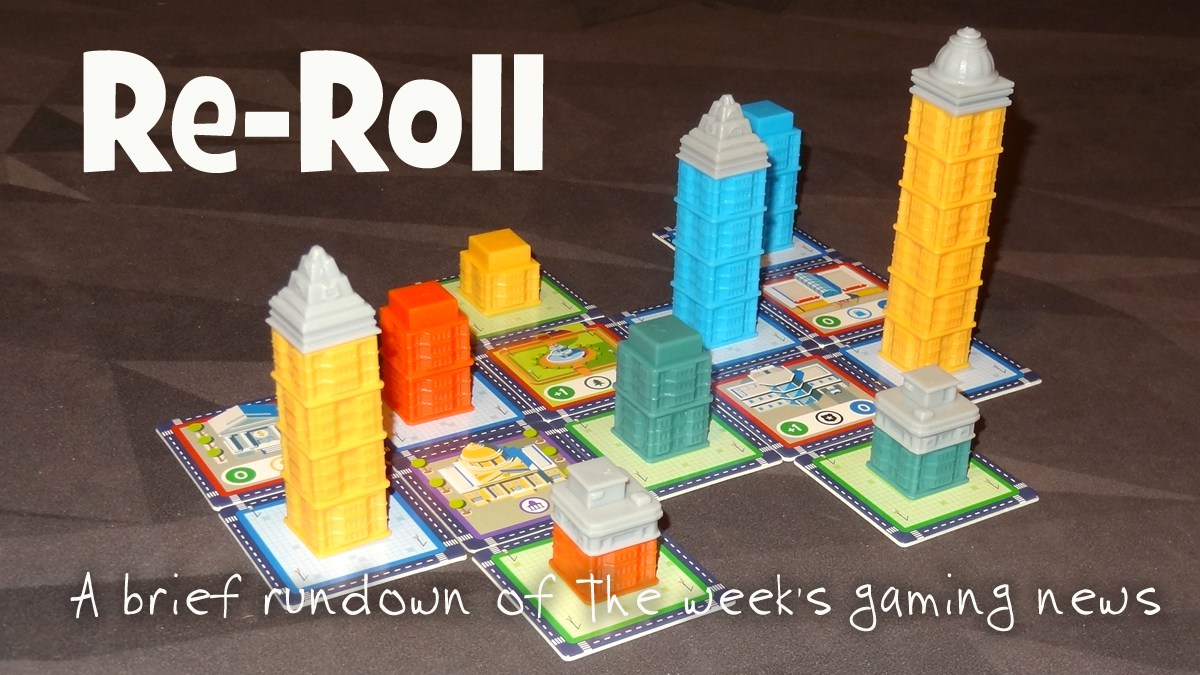The sky is falling! An alien mothership is descending on the city, sending waves of fighter ships. Can you defend the city from your underground bunker long enough for your researchers to find the mothership’s weakness?
What Is Under Falling Skies?
Under Falling Skies is an alien invasion game for 1 player, ages 12 and up, and takes about 20–40 minutes to play. It was released in October 2020, and the first printing sold out quickly; the reprint should be arriving in stores this month, with a retail price of $29.95. Under Falling Skies was originally released as a free print-and-play (which you can still download), and the retail edition adds more content and artwork. While it is a solo game, it’s the sort of game that you could easily play together with younger kids, just discussing what moves to make. The alien invasion theme (and artwork) does include explosions and an alien autopsy scene, but nothing especially graphic, so it may be okay for kids younger than 12 as well.
Under Falling Skies was designed by Tomáš Uhlíř and published by Czech Games Edition, with illustrations by Kwanchai Moriya and Petr Boháček.
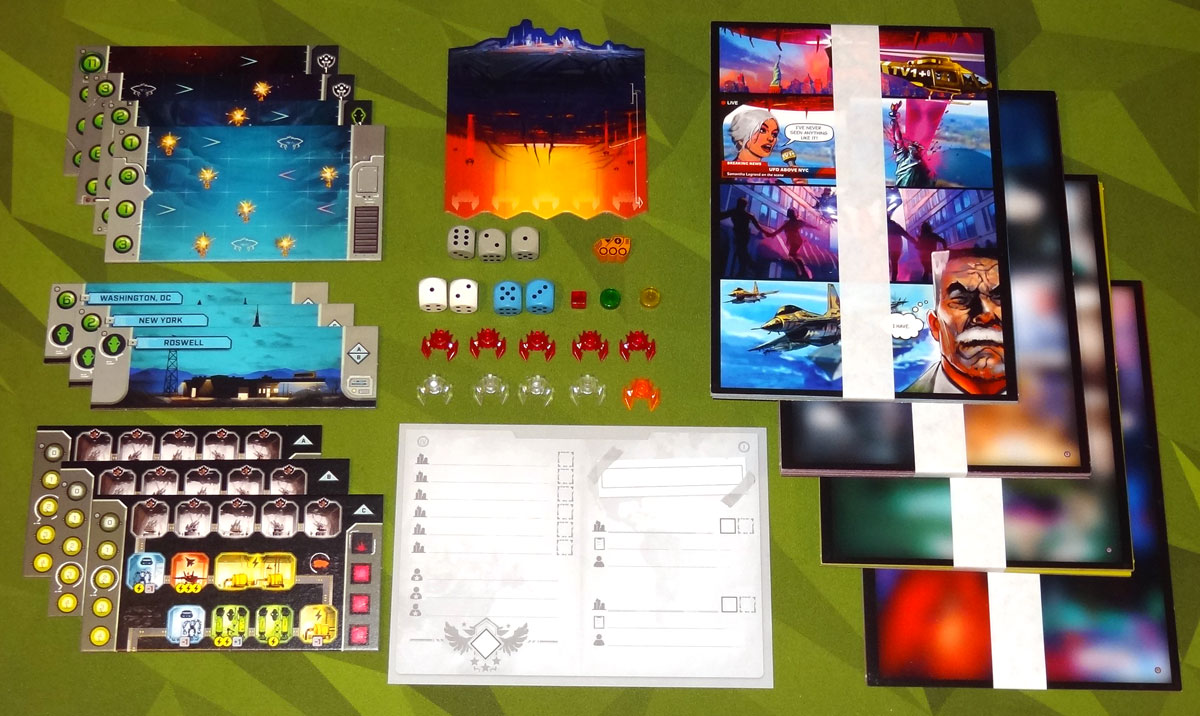
Under Falling Skies Components
Under Falling Skies has a standard game, plus a campaign that you can play through with additional rules and components that are gradually revealed.
Here’s what comes in the box. First, the standard game components:
- 5 Purple ships
- 4 White ships
- City Damage marker
- Research marker
- Energy marker
- 7 wooden dice (3 grey, 2 white, 2 blue)
- Excavator token
- Mothership tile
- 4 Sky tiles
- 3 Underground Base tiles
- 3 City tiles
Next, the campaign-specific components. I’ll provide the list, but will avoid revealing more than just the first chapter’s worth of components. CGE also sent a media copy that has blurred-out components, so you can see what’s included without revealing the storyline or the specifics of the gameplay.
- Campaign notebook
- 4 Chapter sheets
- 14 City tiles
- 12 Character tiles
- 13 Scenario tiles
- 9 Base and Sky tiles
- Cardboard tokens
- Orange ship
All of the tiles are sturdy cardboard, and generally rectangular except for the mothership, which is cut at the top to fit the profile of the mothership. The tiles line up to form a large, long grid representing a narrow section of the sky below the mothership, with lots of icons scattered across the grid for various effects. The sky tiles aren’t numbered to show which order they go in, so you have to rely on the color of the sky, which gets darker as you get higher into space. The back of the mothership tile has a gameplay reminder, which is nice—though it will start off pretty far away from you.
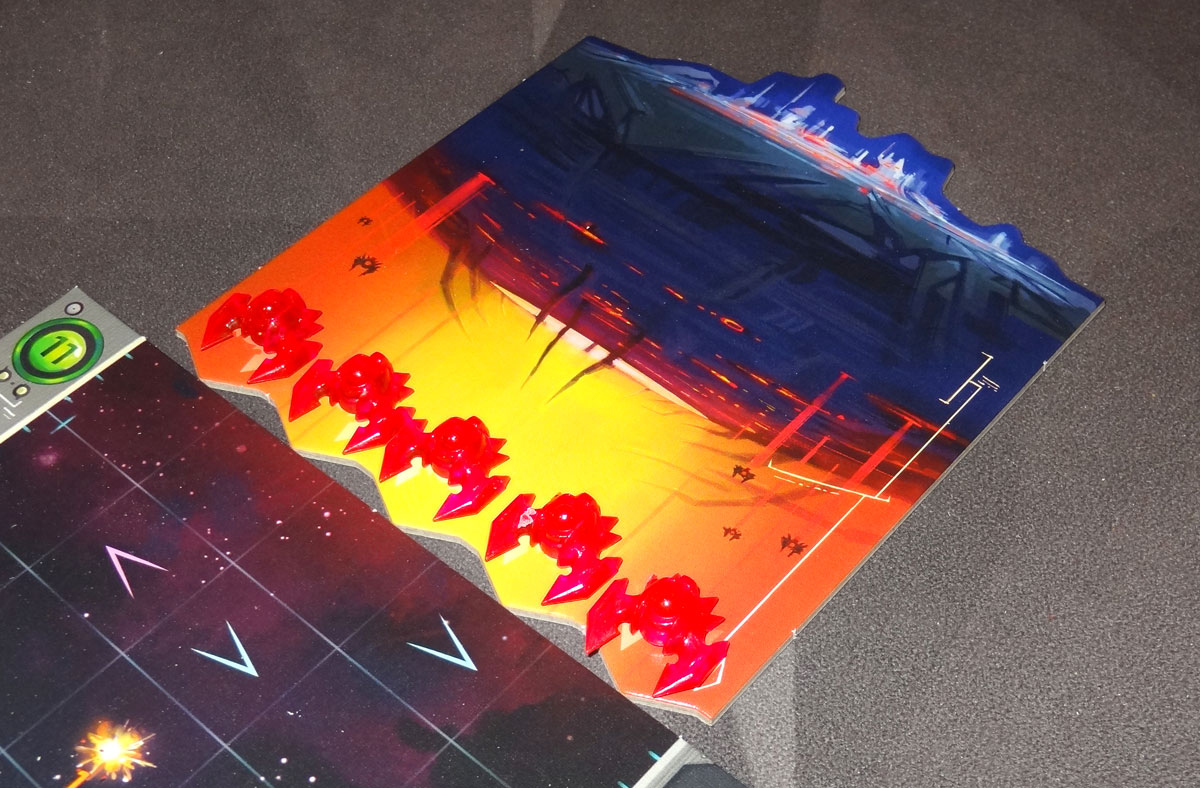
The plastic ships are all identical shapes in three different colors. The wings are quite pointy, and the flat profile can make them a little difficult to pick up sometimes, though they look cool. I like them, but I do wish they were a little easier to handle. The other custom piece is the excavator, a little orange meeple that looks like a drilling machine, which is also screen printed on both sides. The three other tracking tokens are simple clear plastic tokens.
There are some comic-book-style pages used in the campaign: a single page introducing each chapter, and the scenario tiles (which are about a quarter page) have a small comic on one side just setting the scene for the scenario. Since they’re one-page comics, there’s not enough room to get into a lot of detail, so they feel a little more like snapshots, just a quick glimpse at the unfolding events rather than a fully fleshed-out story. Without revealing too much about the campaign itself, I liked the way that it featured several major cities from around the world, and the characters are a diverse cast as well, both in their ethnicities and in their occupations. The campaign materials are all labeled with a tiny number so you can tell which chapter they came from.
How to Play Under Falling Skies
You can download a copy of the rulebook here.
The Goal
The goal of the game is to reach the top of the research track before your city takes too much damage or the mothership descends to the bottom of the track.

Setup
Lay out the sky tiles in order, with the lightest ones nearest you and darkest ones farthest away. If you want to increase the difficulty, you can flip a number of sky tiles over to the more advanced side, which is marked with purple splatters on the research track. The mothership is placed at the top of the sky, and below the sky, you place the city tile (Roswell for the starting game) and then the two underground base tiles placed so they match the letter icons shown on the city (in Roswell’s case, “A” on top and “B” on bottom).
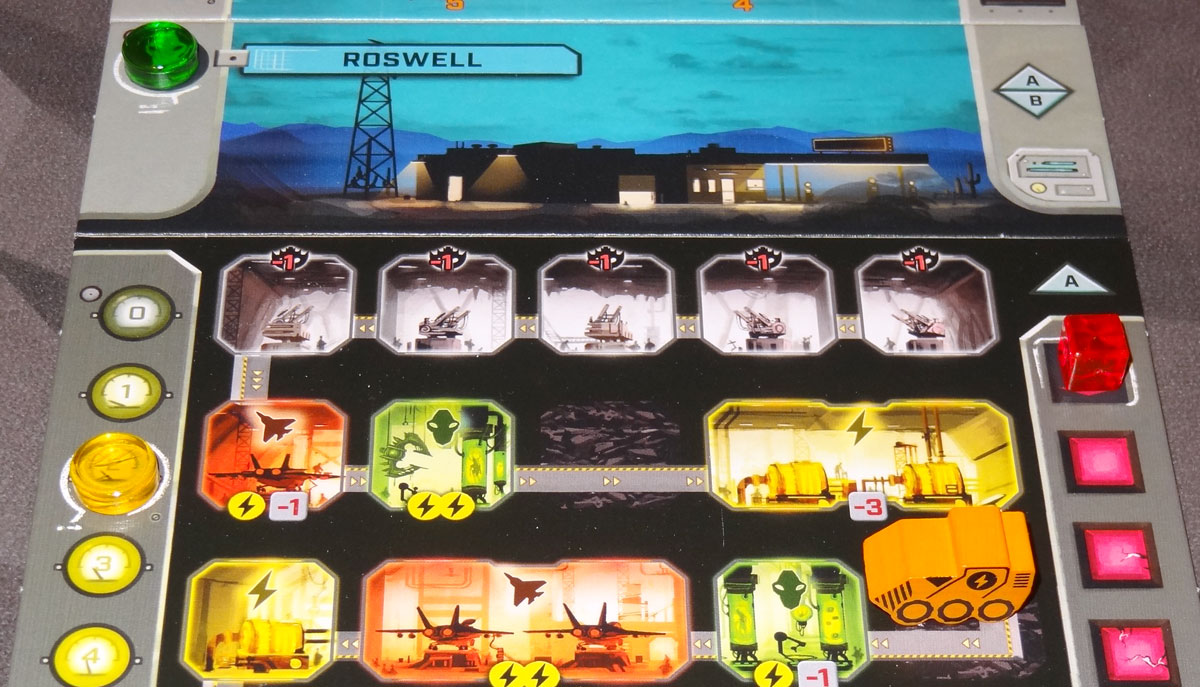
Place the markers on the starting locations: the research marker starts at the bottom, the damage marker starts at the top, and the energy marker starts on its starting space, which varies depending on the base. The starting spaces are all indicated with a small white outline. Place the excavator on its starting space (marked with an icon of the excavator).
Place the 5 purple ships on the spawning points on the mothership tile, and set the white ships nearby. Also, have the grey and white dice ready. (If you’re using a base that has blue robot rooms, then set the blue dice nearby as well.)
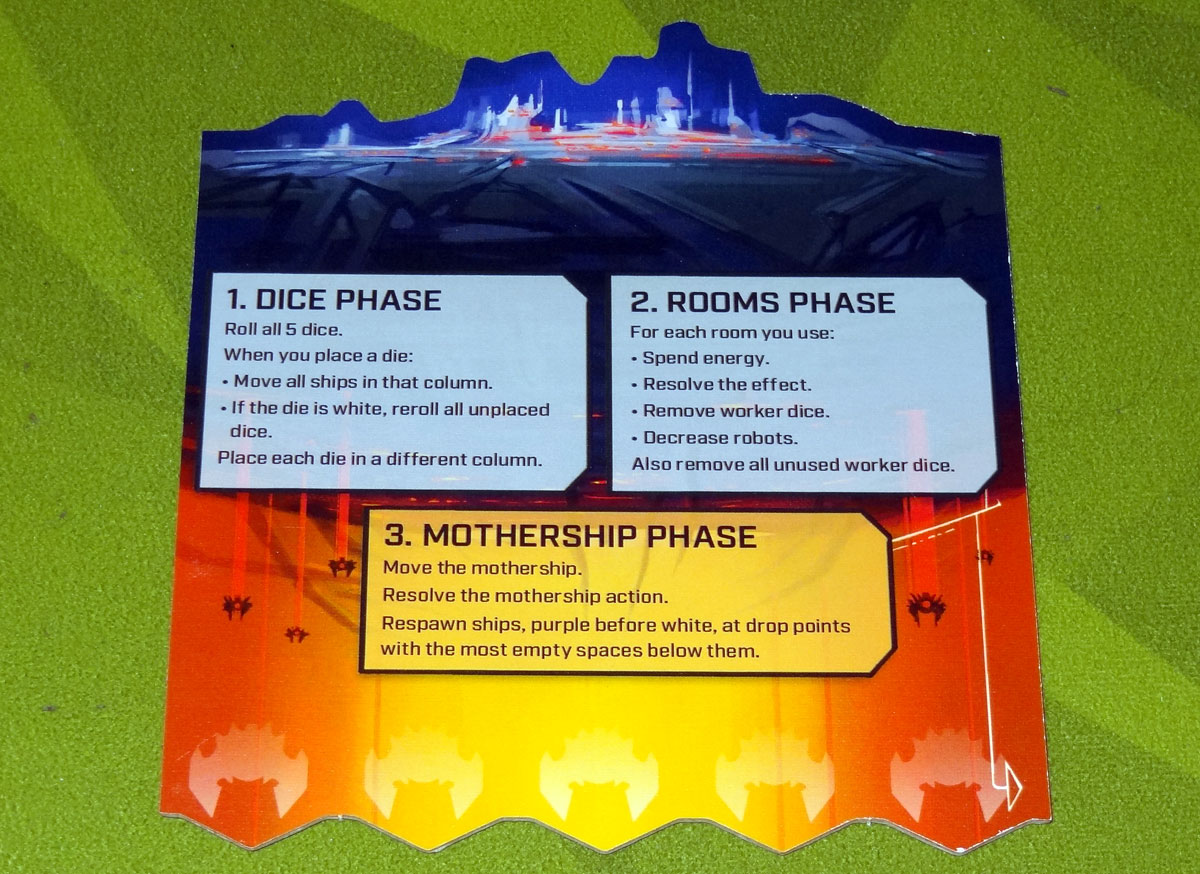
Gameplay
Each round has three phases: Dice Phase, Rooms Phase, and Mothership Phase.
Dice Phase
Roll all of the grey and white dice. Place each die in a different column in your base. Each time you place a die, any alien ships in that column move down (toward you) the number of spaces shown on the die, and if they end on an icon then they may trigger an effect. Ships may move left or right into a different column or move the entire mothership down one row. If it lands on an explosion space, then it is vulnerable to your fighter pilots (the orange rooms). If a ship moves all the way down the grid and reaches the city tile, then your city takes 1 damage, moving the red cube down a space.
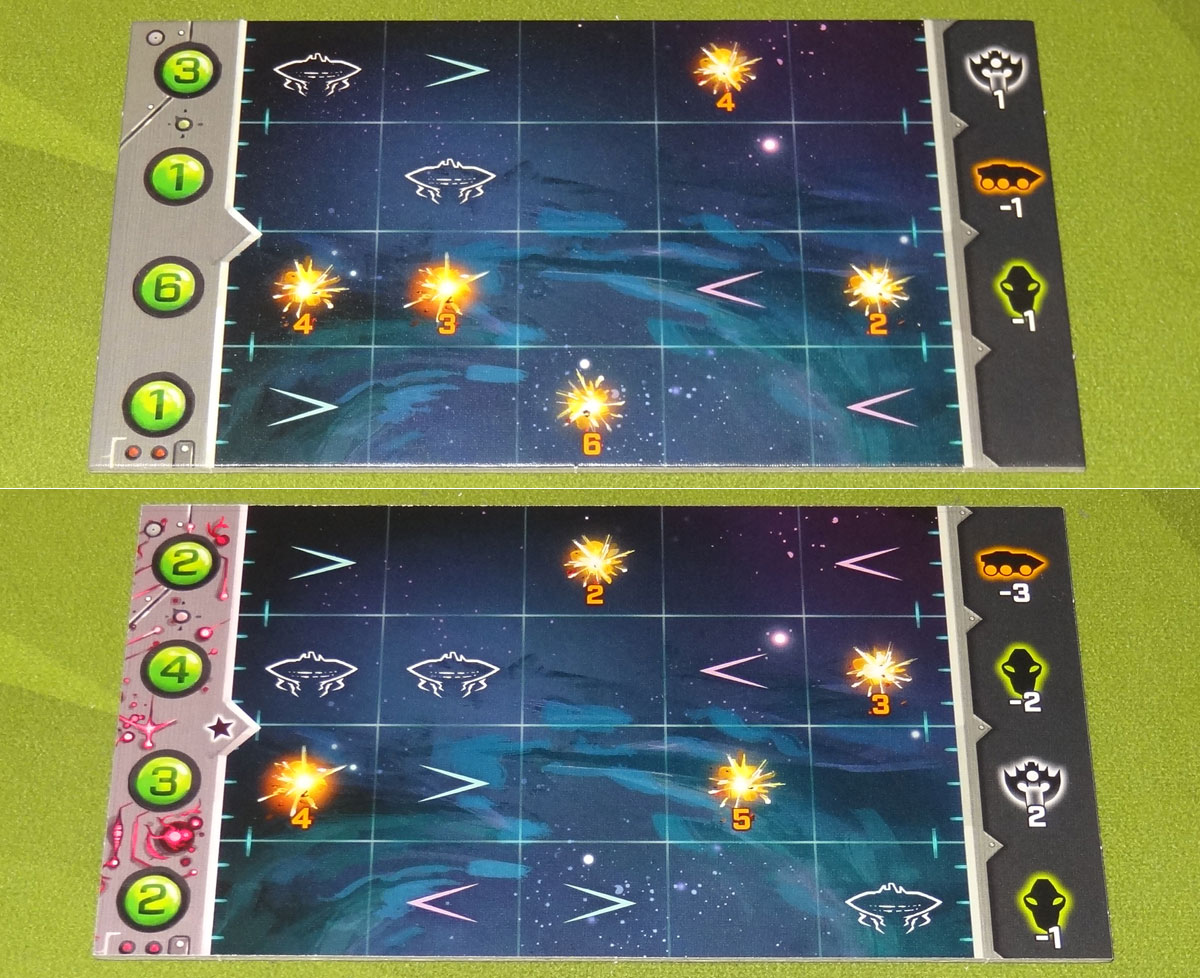
The anti-aircraft rooms at the top of your base have a “-1” icon at the top: when you place a die here, you move the alien ship 1 less than the value of the die.
You may only place dice in spaces down to where the excavator is—the idea is that the excavator is digging out your underground base, opening up more actions. You may spend one of your dice to excavate, placing it ahead of the excavator a number of spaces up to the die’s value.
Every time you place a white die, you must reroll all of your unplaced dice.
Rooms Phase
During the rooms phase, you activate the rooms where you’ve placed dice, one room at a time in the order of your choice. If the room has lightning bolt symbols at the bottom, you must spend that much energy to use the room, or else the die is just removed with no effect. The room activates with the value of the dice in it, though some rooms may add or subtract to the value, as shown at the bottom of the room. Also, there are multi-space rooms, and their value is the sum of the dice in them.
Yellow rooms give you energy. Green rooms move you up the research track—the value of the room is how much you have to “spend” on the track. and you can only move up one or more spaces if you have enough to cover the cost of the research. Any leftover value is lost. Orange rooms let you destroy all the alien ships that are on explosion spaces with a number that’s equal to or less than the value of the room. (Destroyed purple ships are placed back onto the center of the mothership tile; destroyed white ships are placed back into the supply.)
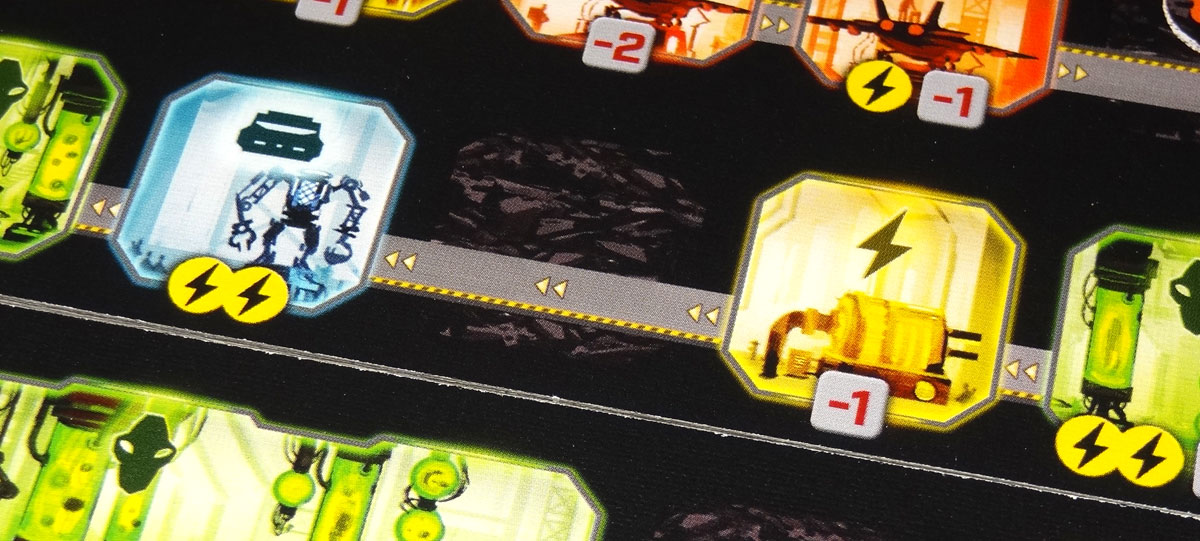
Blue rooms—which will appear in some of the other cities—allow you to install blue dice as robots. Set a blue die to the value of the robot room, and place it in any empty excavated room. Robots are exhausted when installed (turned at a 45-degree angle) so you can’t use them on the turn you installed them, but then they will remain in place, activating in future Rooms Phases. Each time you activate a robot, you decrease the value of the die by 1, until it is removed (or you choose to remove it). Robot dice do not cause the alien ships to descend.
If you used a die for the excavator, you may spend 1 energy to move the excavator to that space, potentially opening up more rooms for dice in the next round.
Mothership Phase
First, the mothership moves down 1 row, and then triggers the effect on the row it reaches. Possible effects are moving the excavator backward, moving your research marker down, damaging the city, and spawning white ships.
After resolving the mothership action, spawn any ships that have been placed on the mothership board. First, you place the purple ships, then white ships if there is room. Ships always spawn over empty columns first, and then they spawn in the point farthest from the highest ship in the column.
Game End
If you reach the top of the research track, you win immediately. If the mothership descends to the row with the skull, or the damage marker moves onto the skull, then you lose.

If you’re playing the full game, if you lose, you can flip your city tile over to the red side and try again. The city tiles indicate which underground base tiles to use for setup, and also include special abilities, which become more powerful on the red side. (As the city is damaged, humanity rallies to its defense.) Roswell doesn’t have a power on its blue side, but the rest of the cities do.
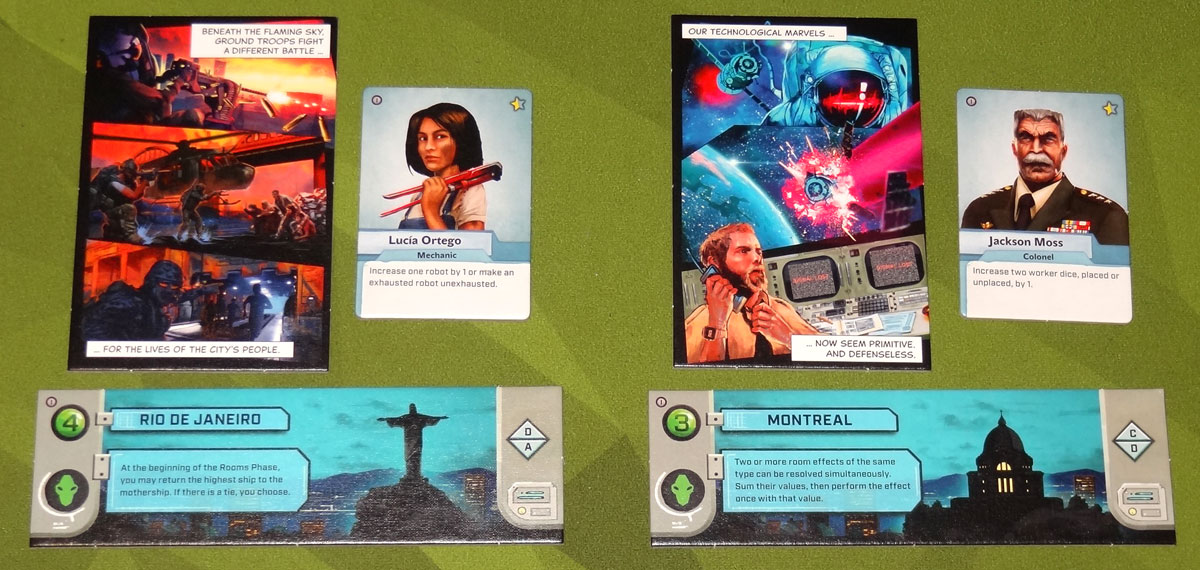
Campaign Mode
Once you’re familiar with the game, you can try the campaign mode. There are four chapters, each bundled in a stack. Each chapter is introduced with a one-page comic with new rules on the back. You’ll also get new city tiles, scenario tiles, and character tiles. You randomly make two piles each containing a city, a character, and a scenario. Choose one pile—this is the battle you’re fighting. Put the other pile back into the box—that city was, alas, destroyed.
Each scenario tile has a comic on one side and special rules for the scenario on the other. The rulebook recommends choosing a battle based on the comic before looking at the specific details about the scenarios, so that next time you play the campaign you can be surprised.
Each character has a special ability that can be used once per game. There’s a blue side, for when the character is first introduced, and a yellow side with an upgraded ability that will come into play in future scenarios… if the character survives.
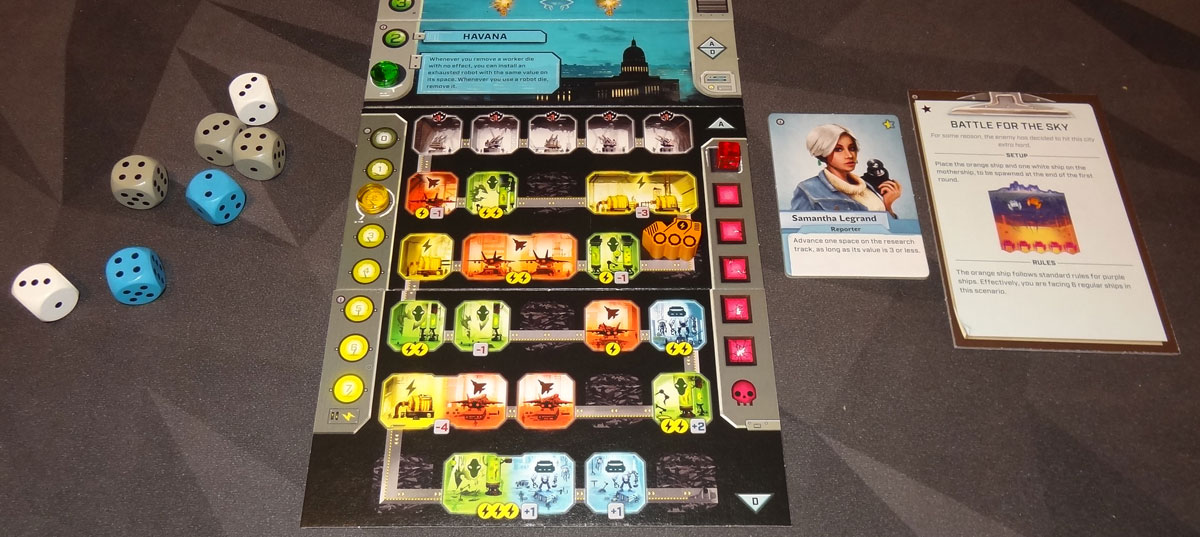
After playing through the scenario (you get two attempts to win), then you make two more randomized piles with the rest of the chapter components, and play another scenario.
Use a scoresheet from the campaign notebook to track your campaign: each battle has spaces to write the city, the scenario name, and the character used. You also record whether you won or lost, and what difficulty setting you used if you won.
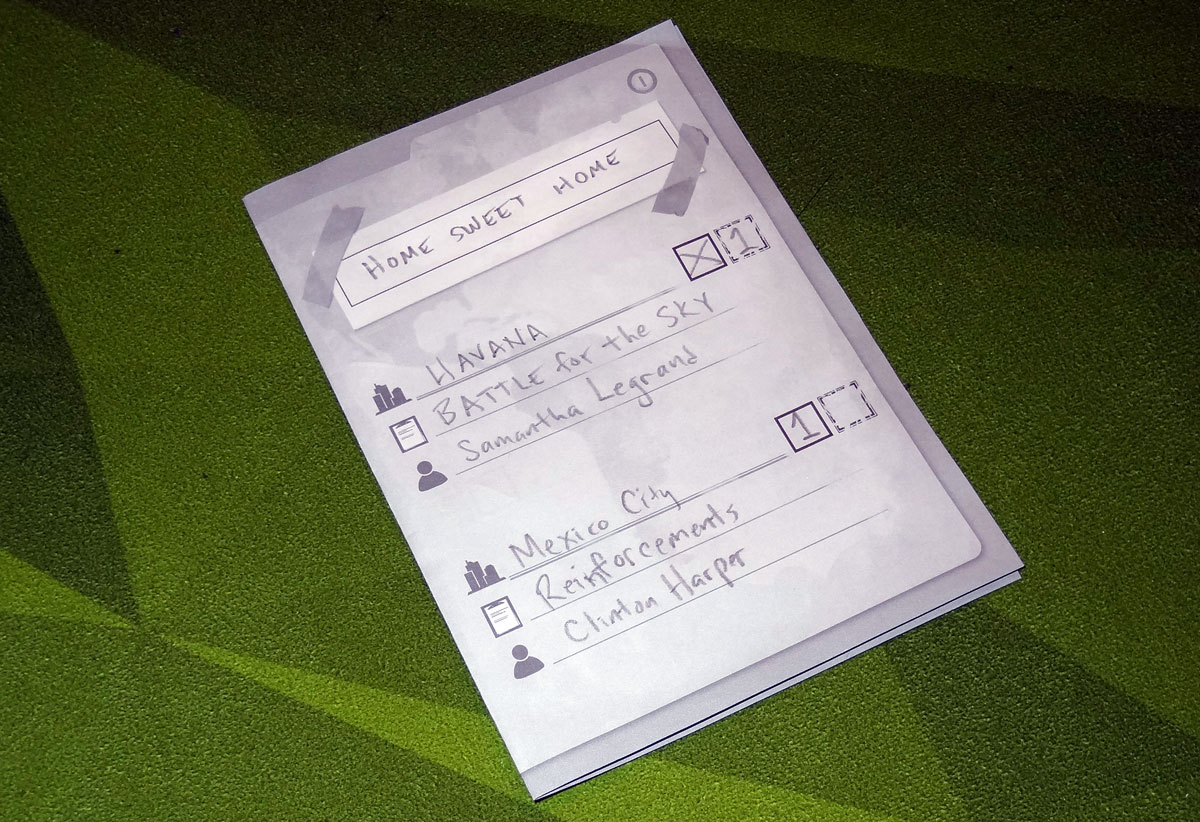
The whole campaign can take anywhere from 7 to 18 plays, depending on how well you fare against the aliens or if you lose any cities entirely. At the end, there are instructions on calculating your final score in the campaign, though there isn’t a chart to tell you how you did.
Why You Should Play Under Falling Skies
Remember that alien invasion movie Independence Day? Playing Under Falling Skies reminds me a lot of that film because the storyline involves a giant mothership hovering over major cities across the globe, sending out waves of fighter ships before blowing the city to smithereens. There’s even a fighter pilot who, while he’s no Will Smith, is probably meant to make you think of him. And, just like the movie, you’re trying to survive the onslaught long enough for your scientists to complete their research, presumably so that (uh, spoiler alert in case you hadn’t seen this 25-year-old movie) Jeff Goldblum can fly up to the mothership with his MacBook and upload a computer virus into their network.
Okay, so that last part isn’t explicitly spelled out in the rules, but it’s what I imagine when I reach the top of the research track and win the game.
That doesn’t always happen, though. Sometimes I fail, and the city blows up. I can almost picture the montage of major landmarks being blasted by giant blazing beams of light.
The game is challenging, and although I’ve played through the campaign once so far, I wouldn’t say I’m great at it. I did manage to make it through the first three chapters without completely losing any cities (you get two tries per city), but I botched the final battle. Sorry, Earth, it was nice knowing you. The game has a tricky balance: the higher the dice values, the more powerful their effects, whether you’re generating energy or shooting down alien fighters or doing research. However, the higher die values also mean the alien ships drop further. Figuring out that balance, or which values you can use in which columns, is one key to winning. Since using a white die means that you reroll any unplaced dice, you can use that to gamble on getting a better number—though sometimes you end up with something worse!
There are a lot of trade-offs to be made as you play. Is it better to play a die so that the mothership drops an extra level? It means you’ve cut yourself short a turn, but if the mothership effect was particularly bad (one of my least favorite is when it moves your excavator backward), then you can skip over it. Skip too often, though, and the mothership will reach that skull in a hurry. Another trade-off is managing how much damage your city can take, and this is where I probably err too often. I try to line up as many ships on the explosion spaces as possible so I can shoot them down, but that’s like playing whack-a-mole: they’re just going to keep coming back. If you shoot them all down but don’t do enough research, eventually the mothership catches up to you and you lose.
I like the way that the rooms work: the modular boards mean that each city has a different feel. Some will require you to make use of the robots so that you can fill in the multi-space rooms for bigger research effects. Some cities have a bigger damage track or more energy. Figuring out how each city works takes some practice, but gives a lot of variety to the games as you play through the campaign.
I also like the way that you can flip the sky tiles over to adjust the difficulty level. I was playing on a fairly easy level for the campaign—only 1 sky tile flipped—but even so, as you progress through the campaign you’ll get more challenging scenarios and sky tiles (balanced by the upgraded character powers).
I don’t generally play a lot of solo games, but this past year I’ve played a bit more as game nights have been put on hold. I enjoyed puzzling over Under Falling Skies, and my daughter often sat with me to watch and comment on my progress (or lack of it!). There are some rules that are easy to forget, so it’s good to look over the official FAQ to make sure you haven’t missed anything. I like the fact that, even though I’ve played through the campaign once so far, I’ve actually only used about half of the content (since half of the cities are blown up as you choose which battles to fight). So that means my next run through the campaign could be entirely new, or else mixed in with some things I’ve already played.
Under Falling Skies gives you a lot of tough decisions to make as you play, with a somewhat familiar sci-fi storyline to give some flavor to it. It’s a clever system, and if you’re looking for a solo game (or one you can figure out together with your kids), then dig in and start researching!
For more about the game, visit the CGE website, or look for it at your local game store!
Click here to see all our tabletop game reviews.
![]() To subscribe to GeekDad’s tabletop gaming coverage, please copy this link and add it to your RSS reader.
To subscribe to GeekDad’s tabletop gaming coverage, please copy this link and add it to your RSS reader.
Disclosure: GeekDad received a copy of this game for review purposes.





